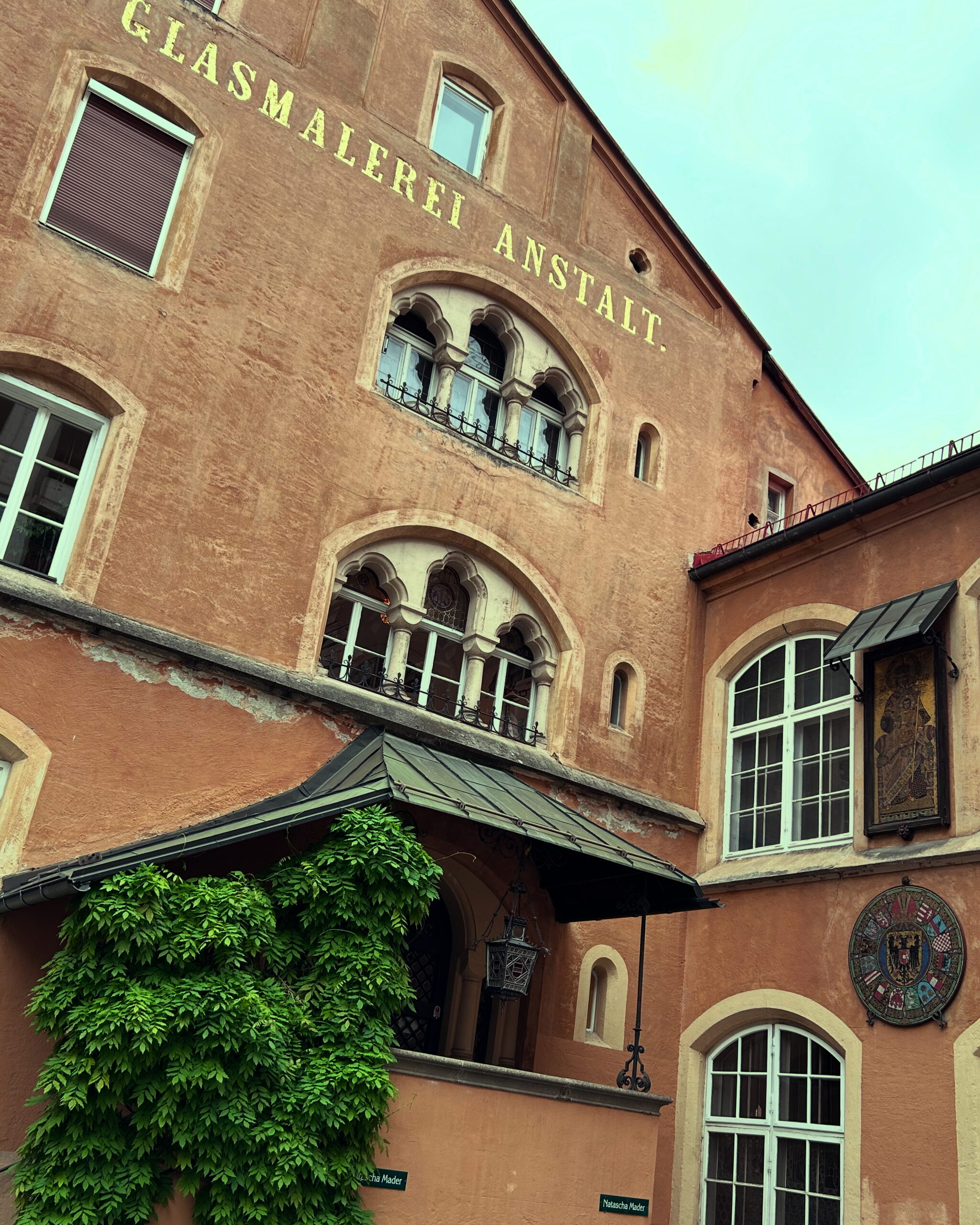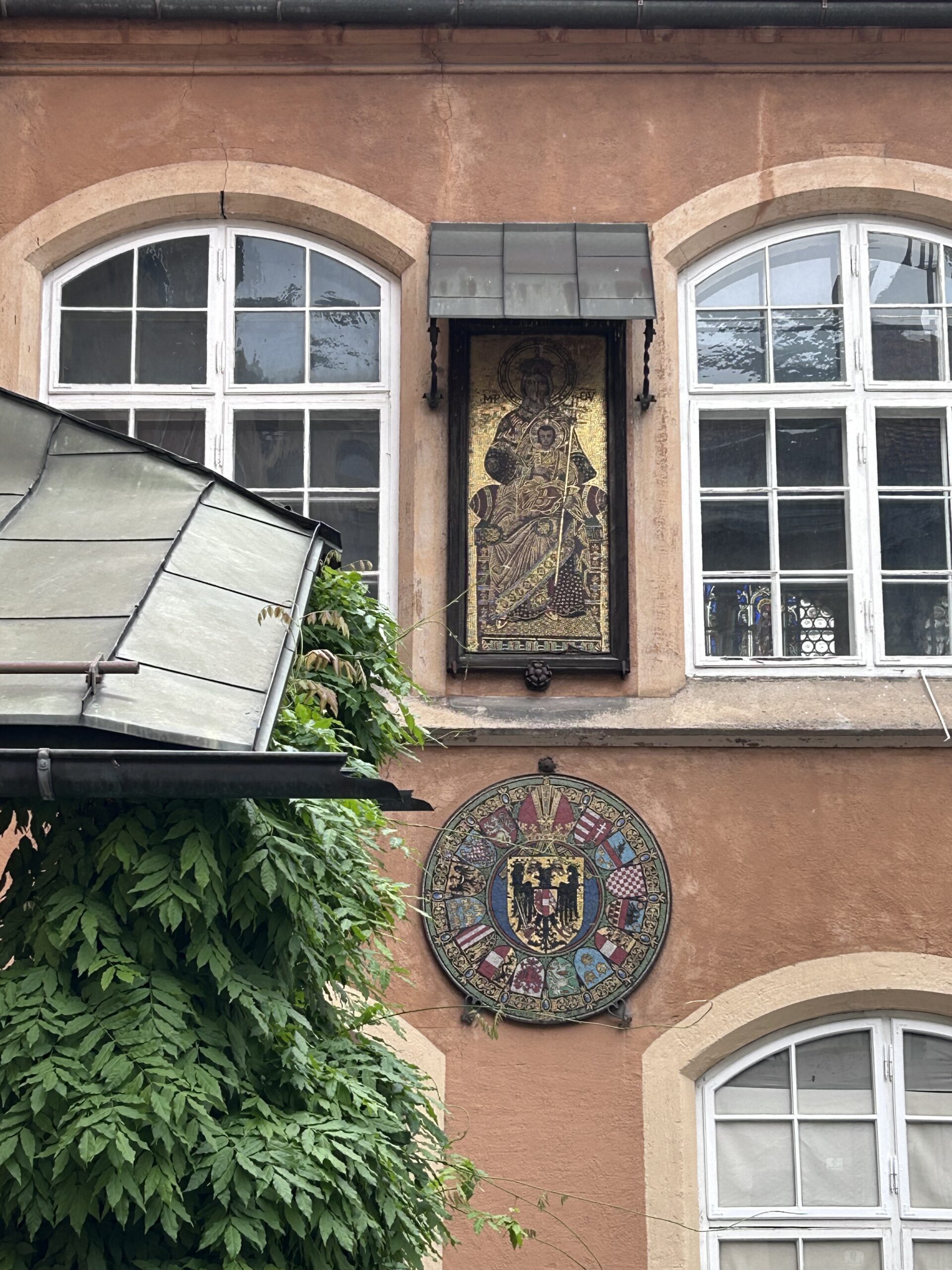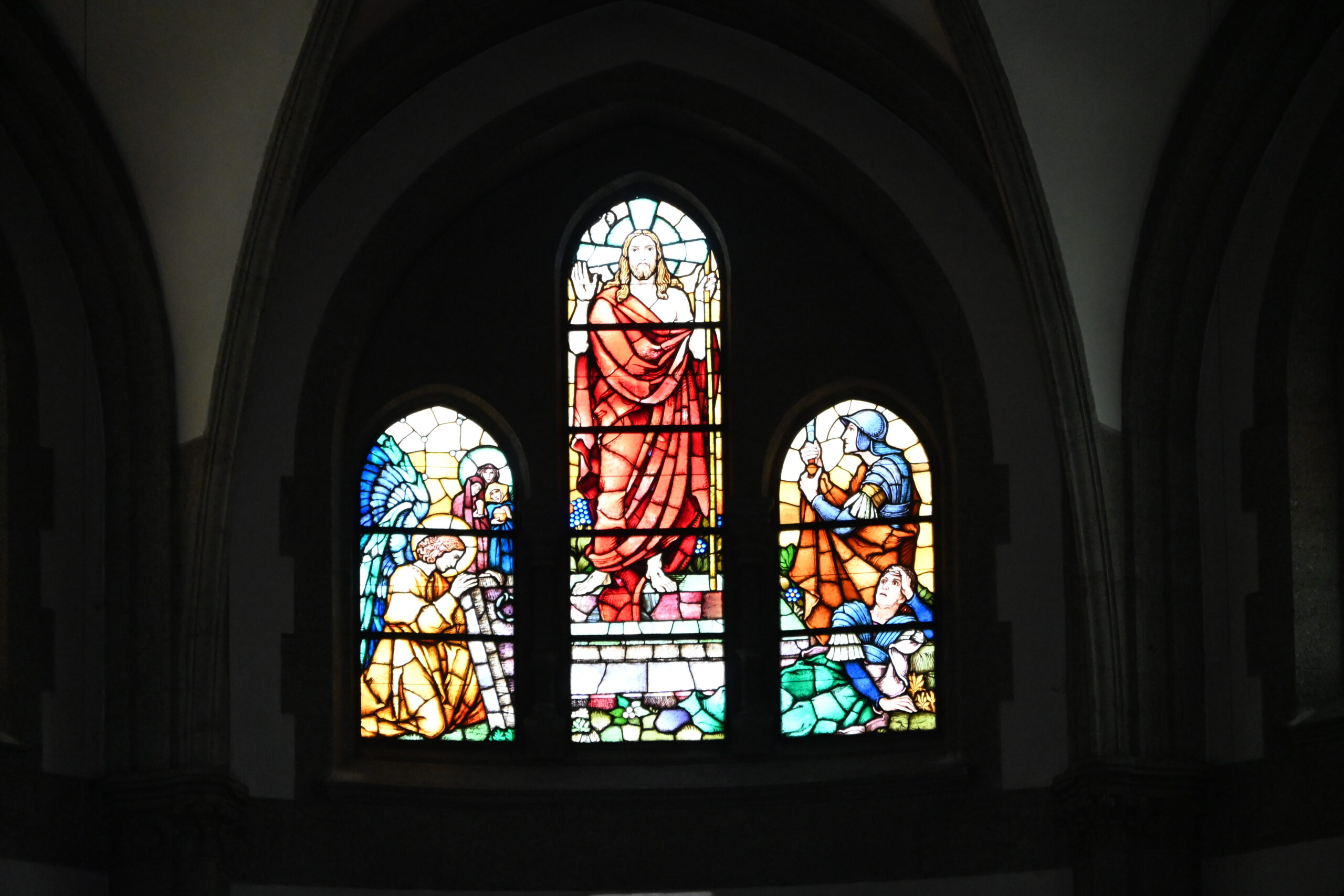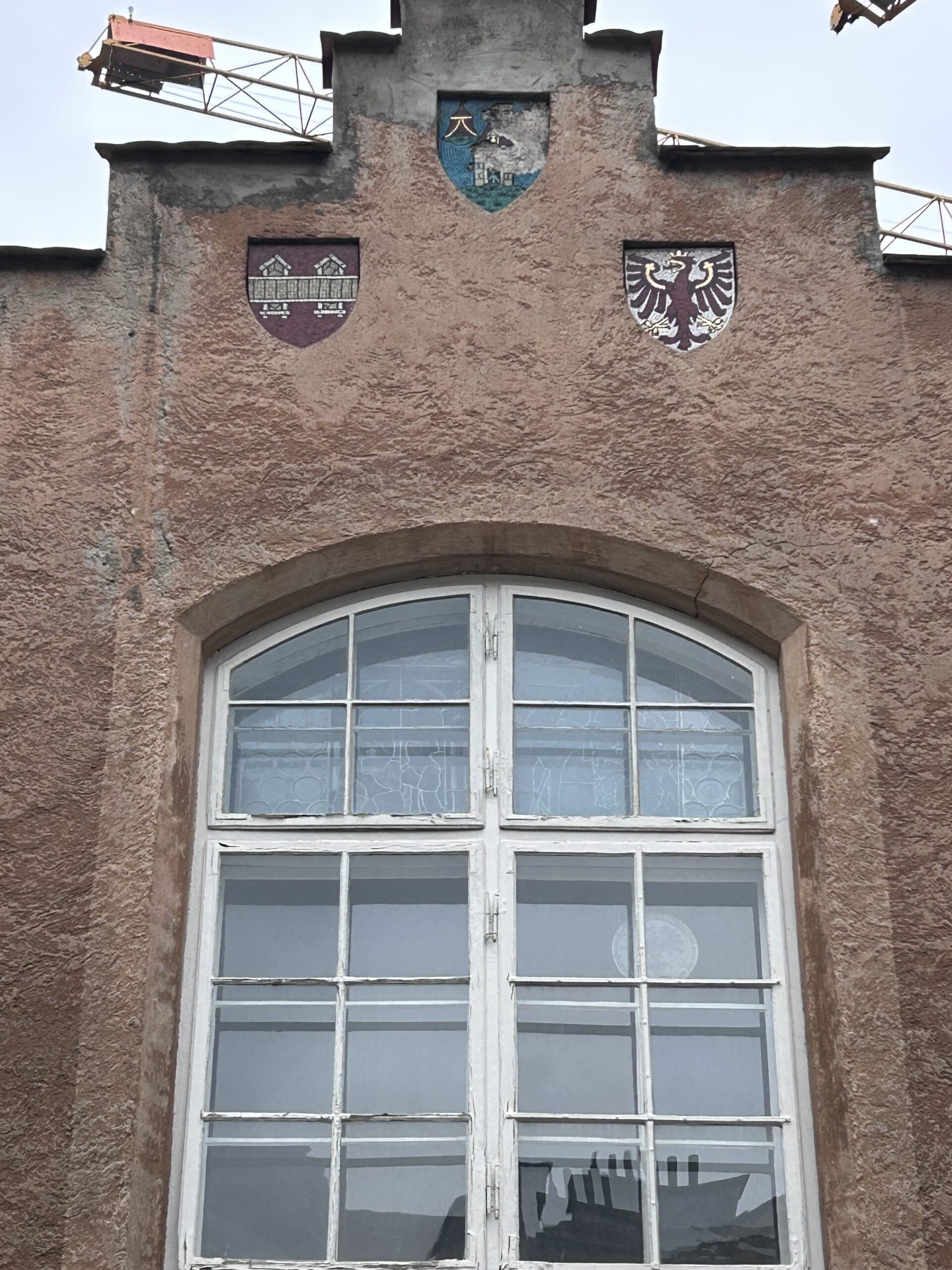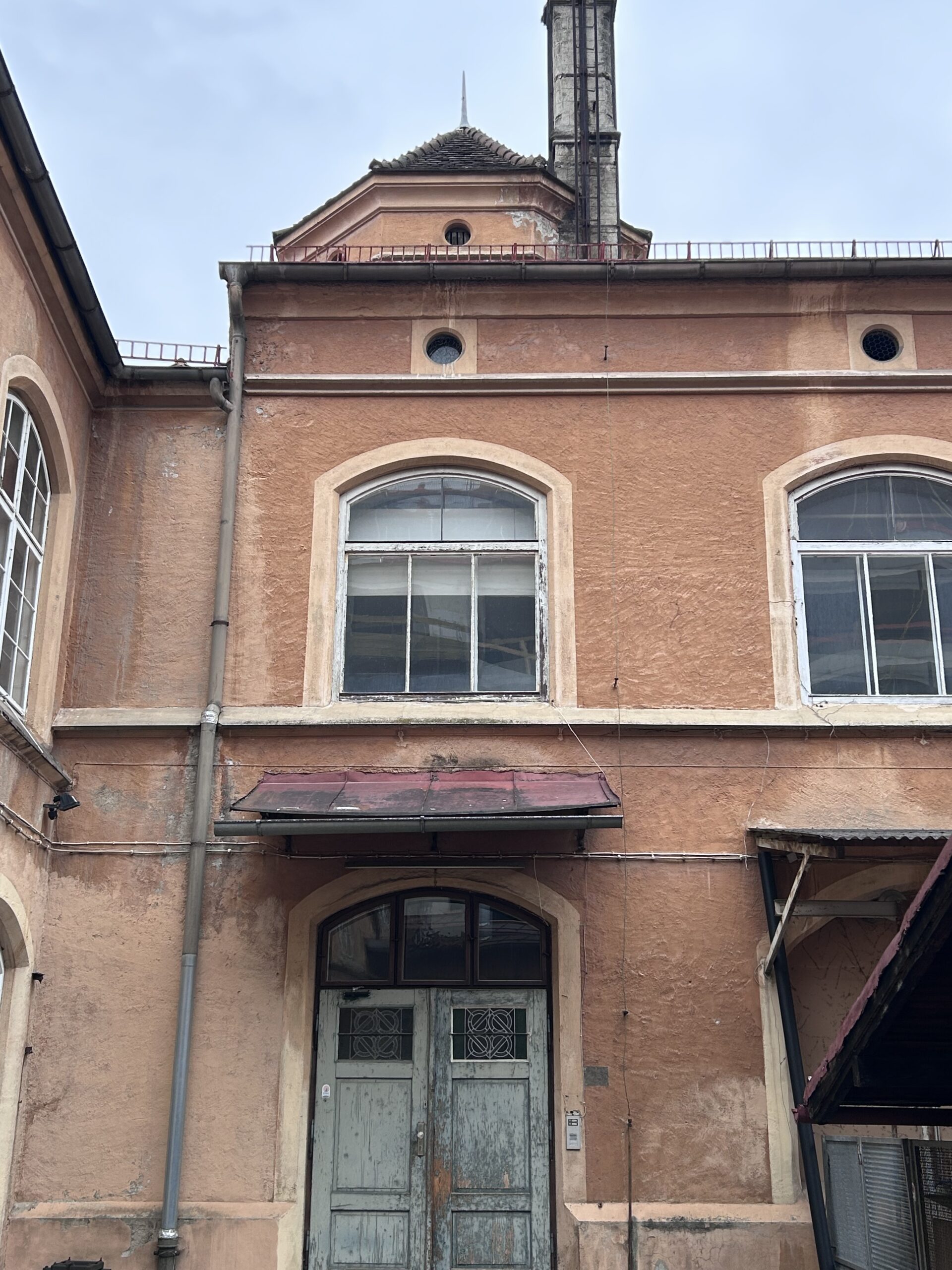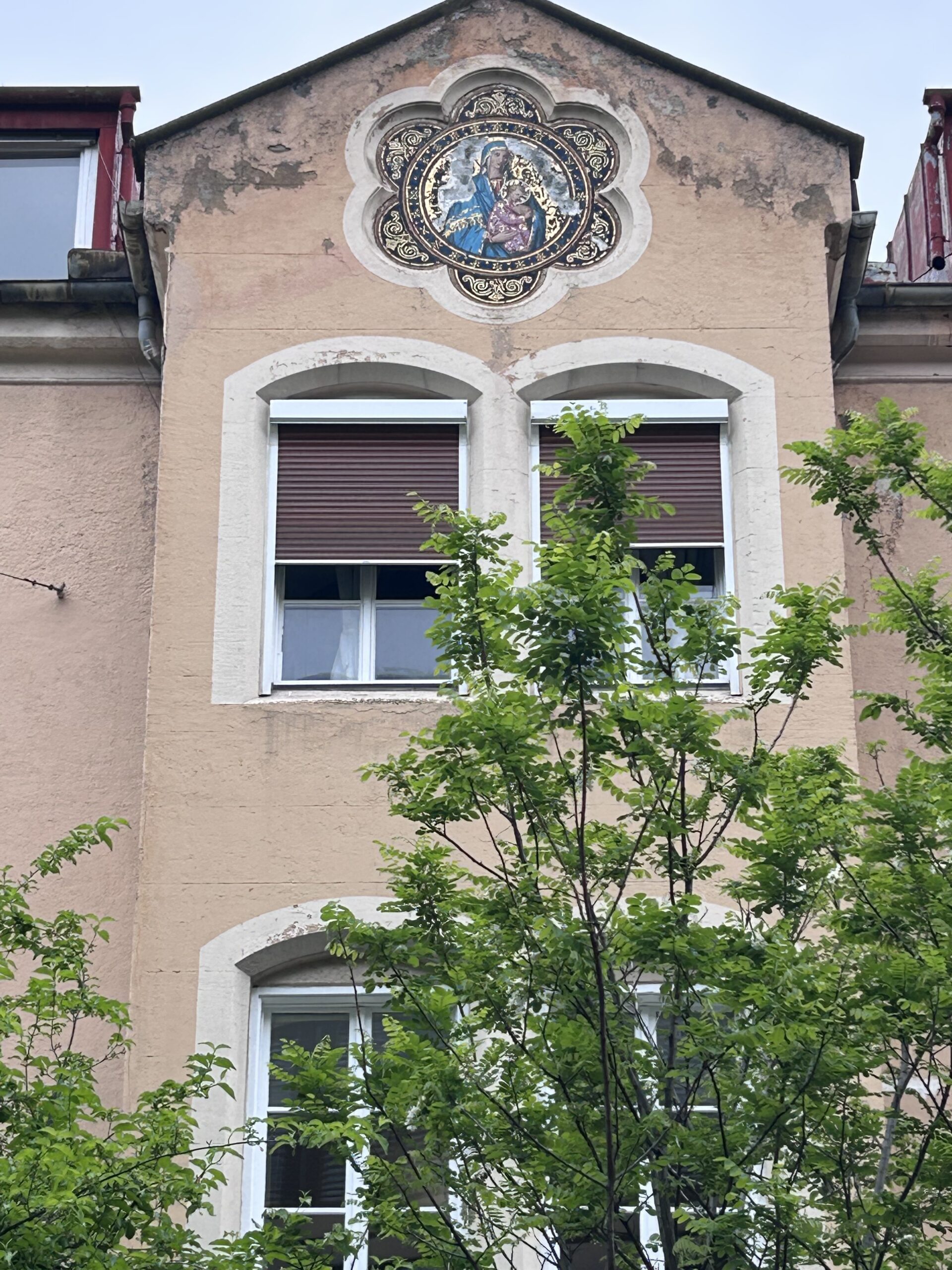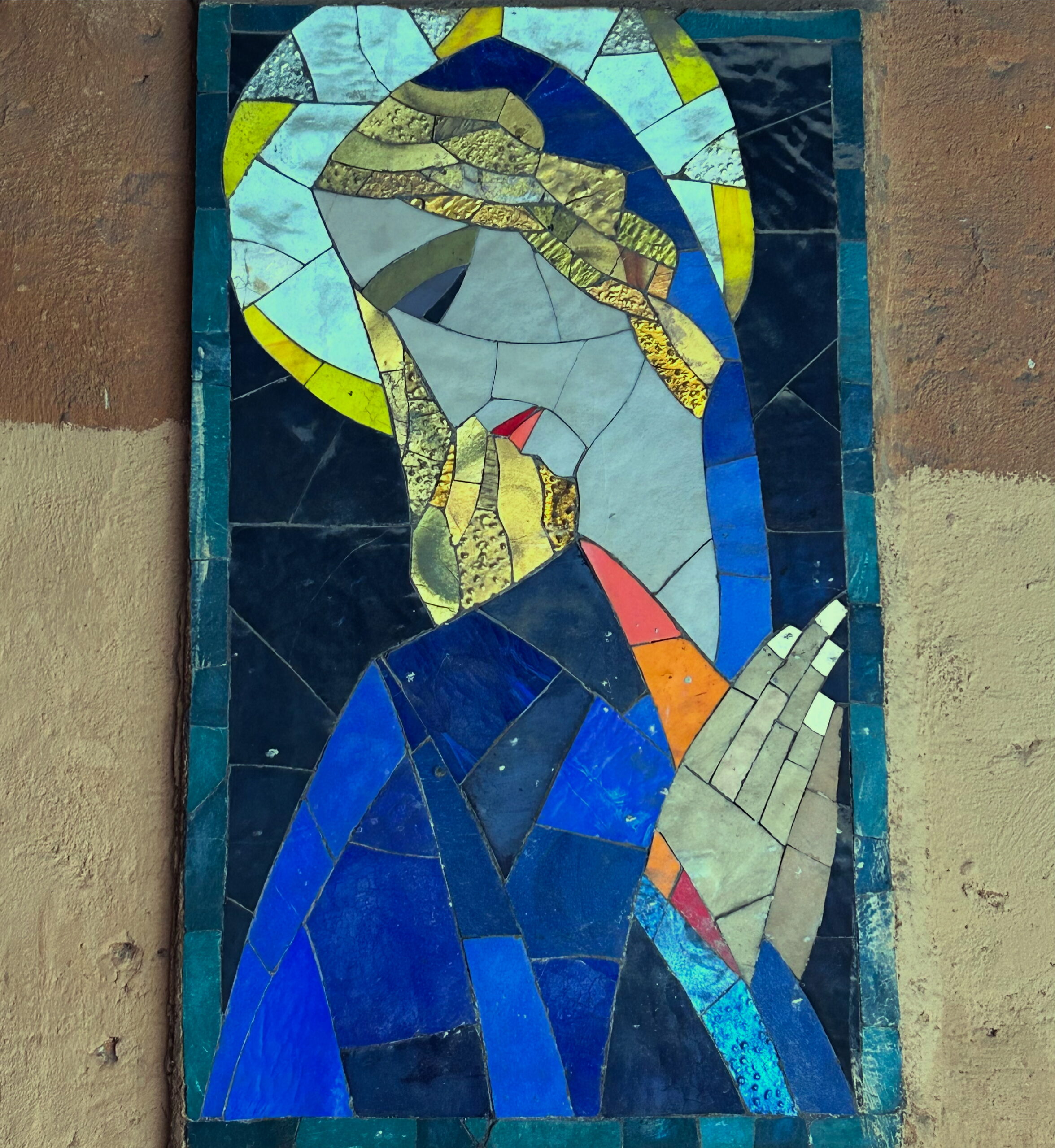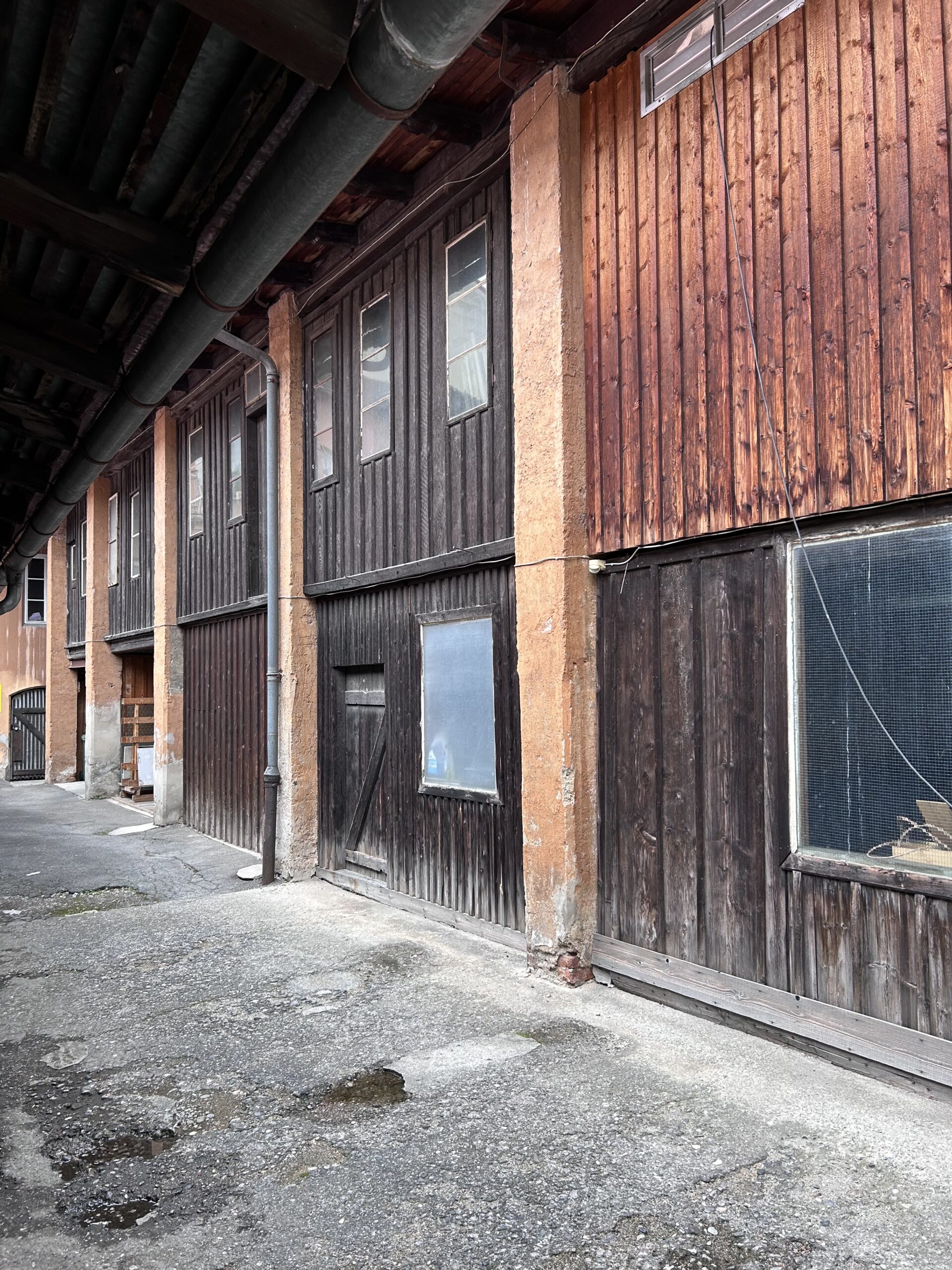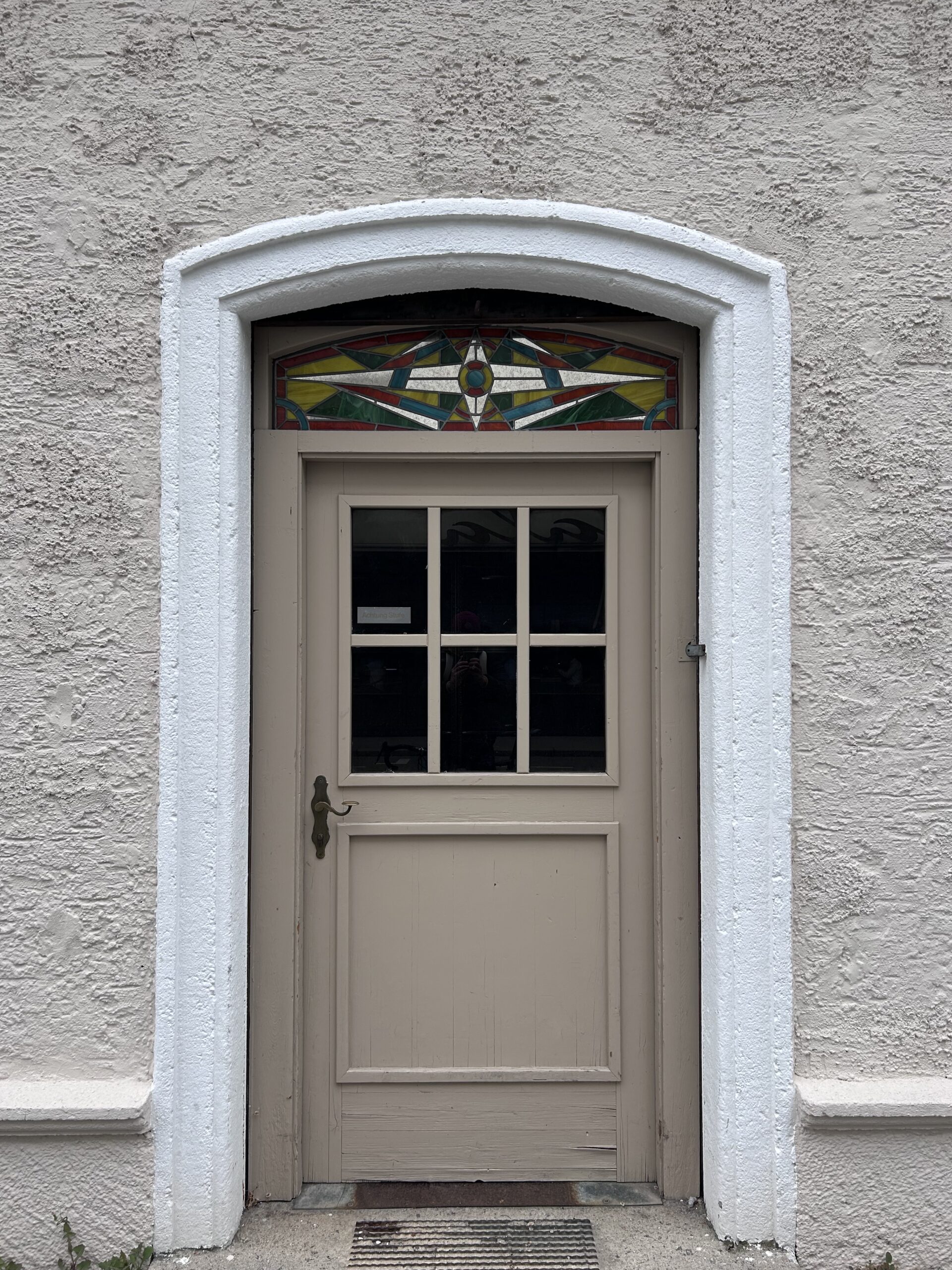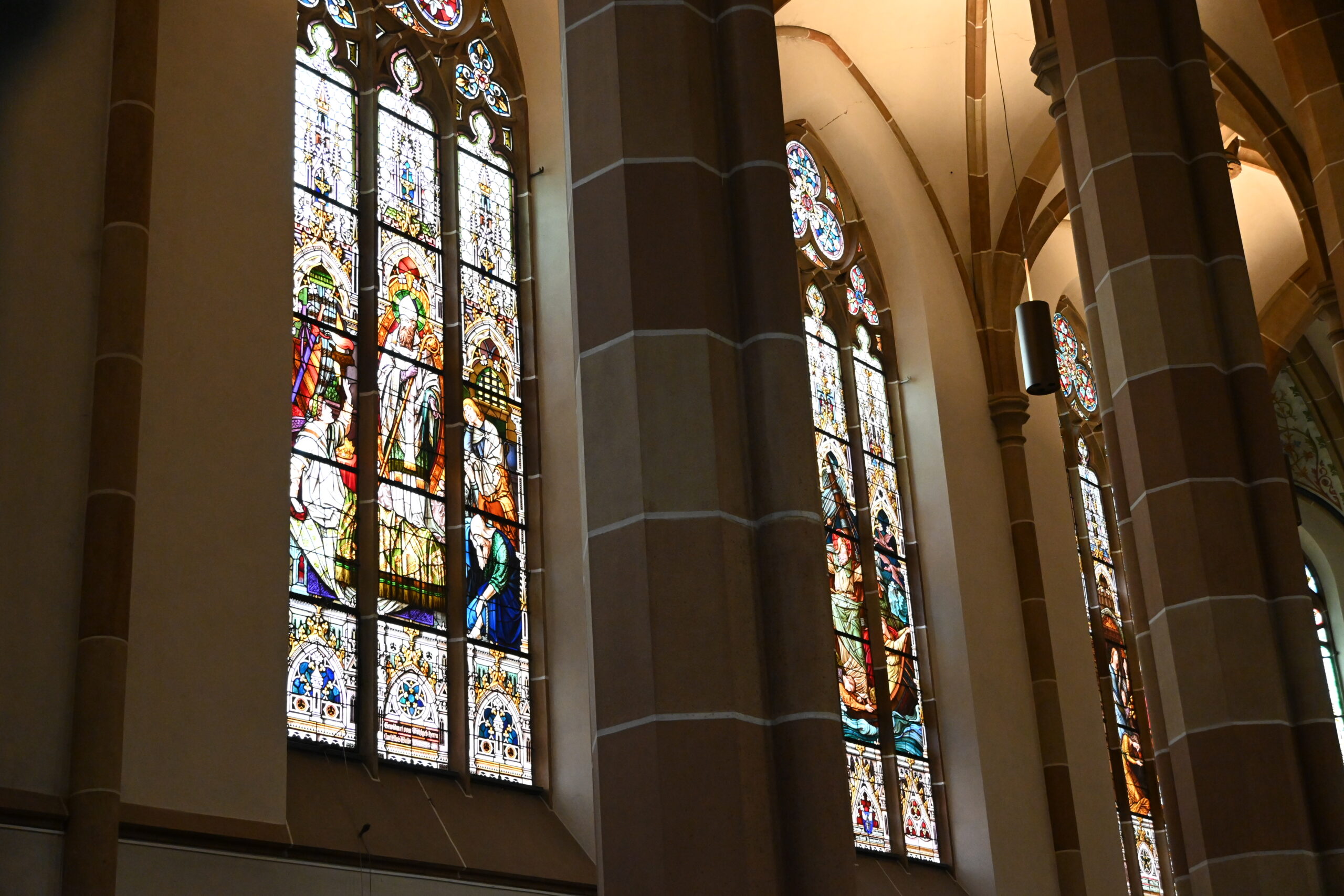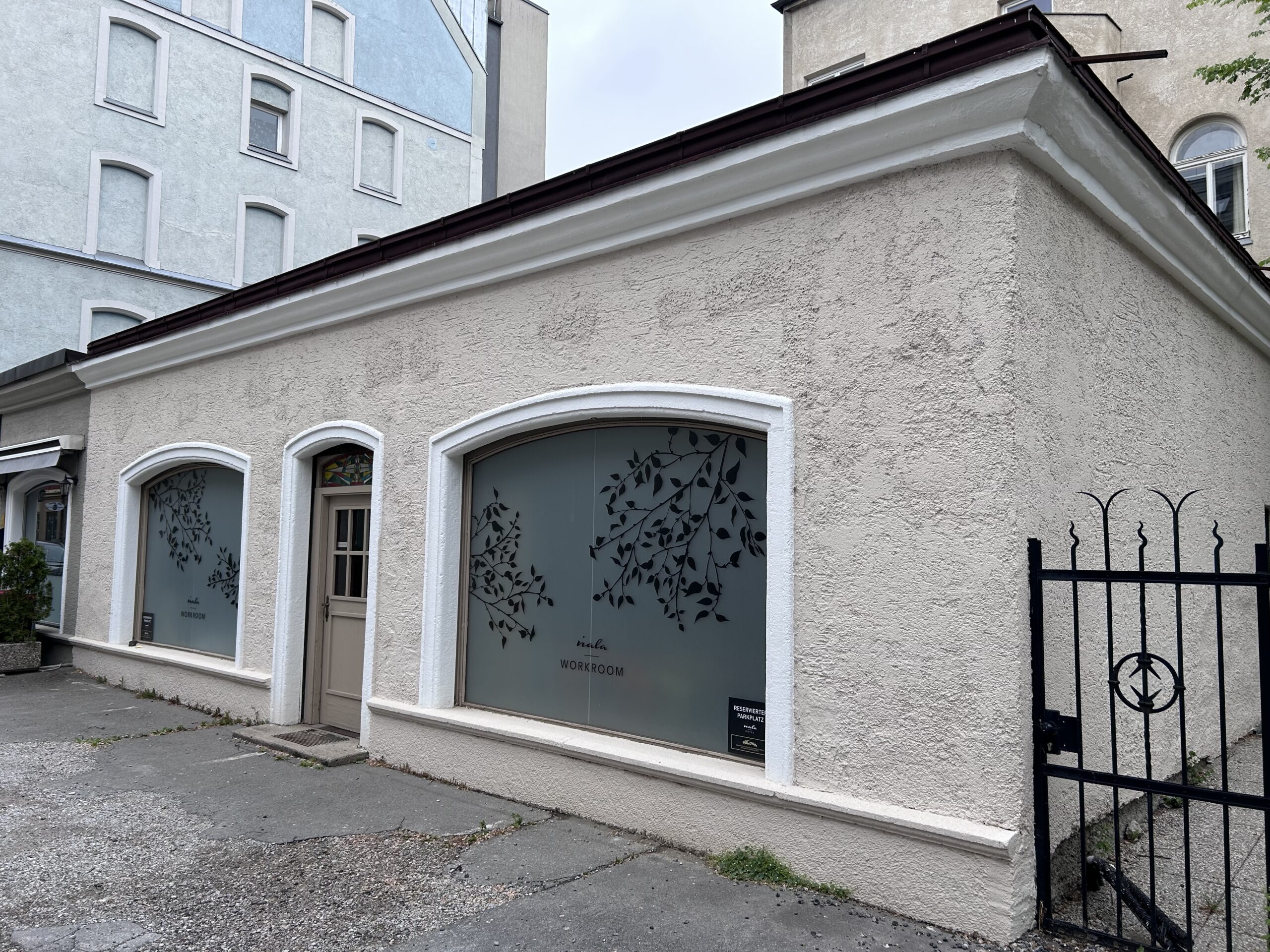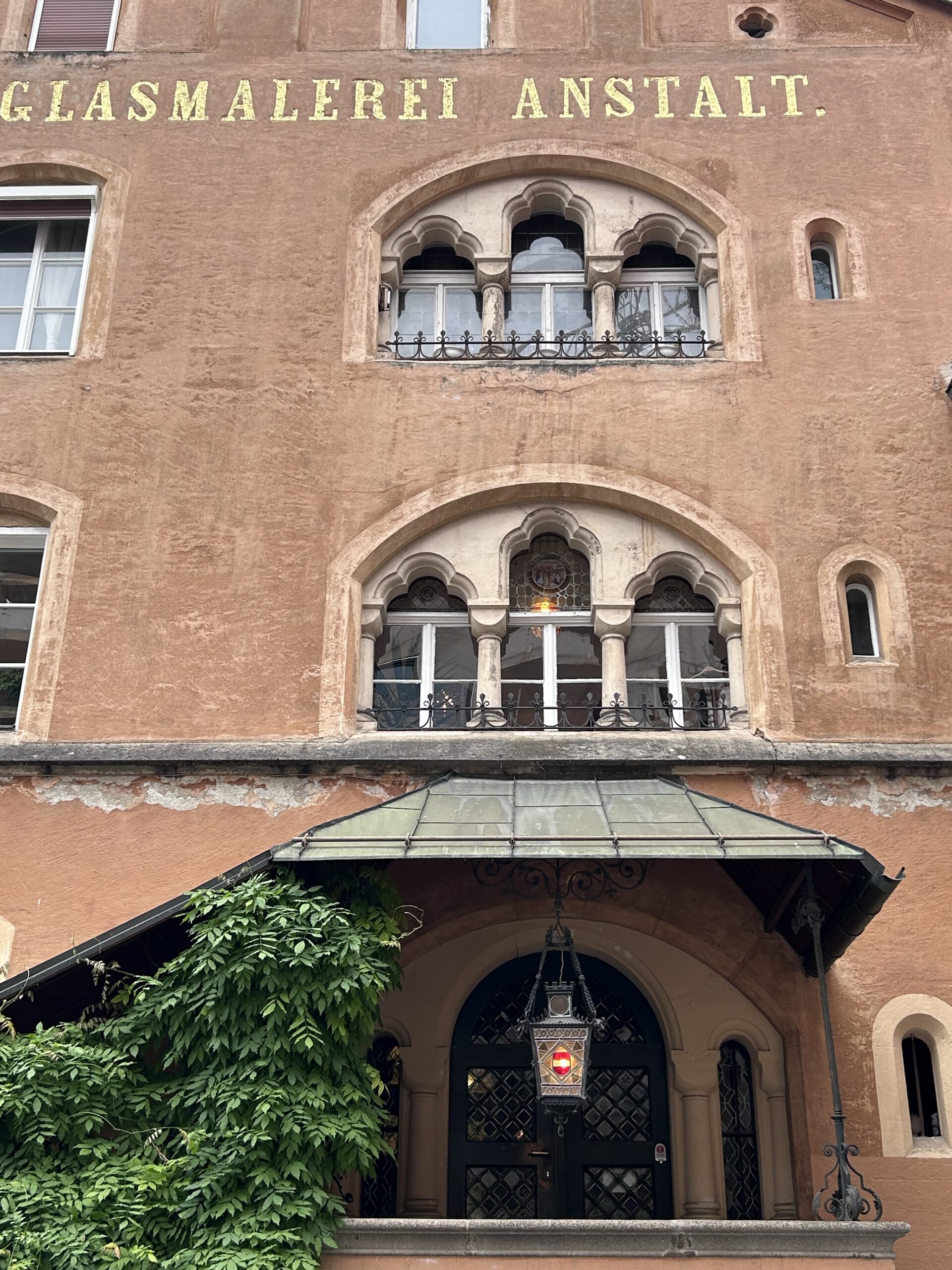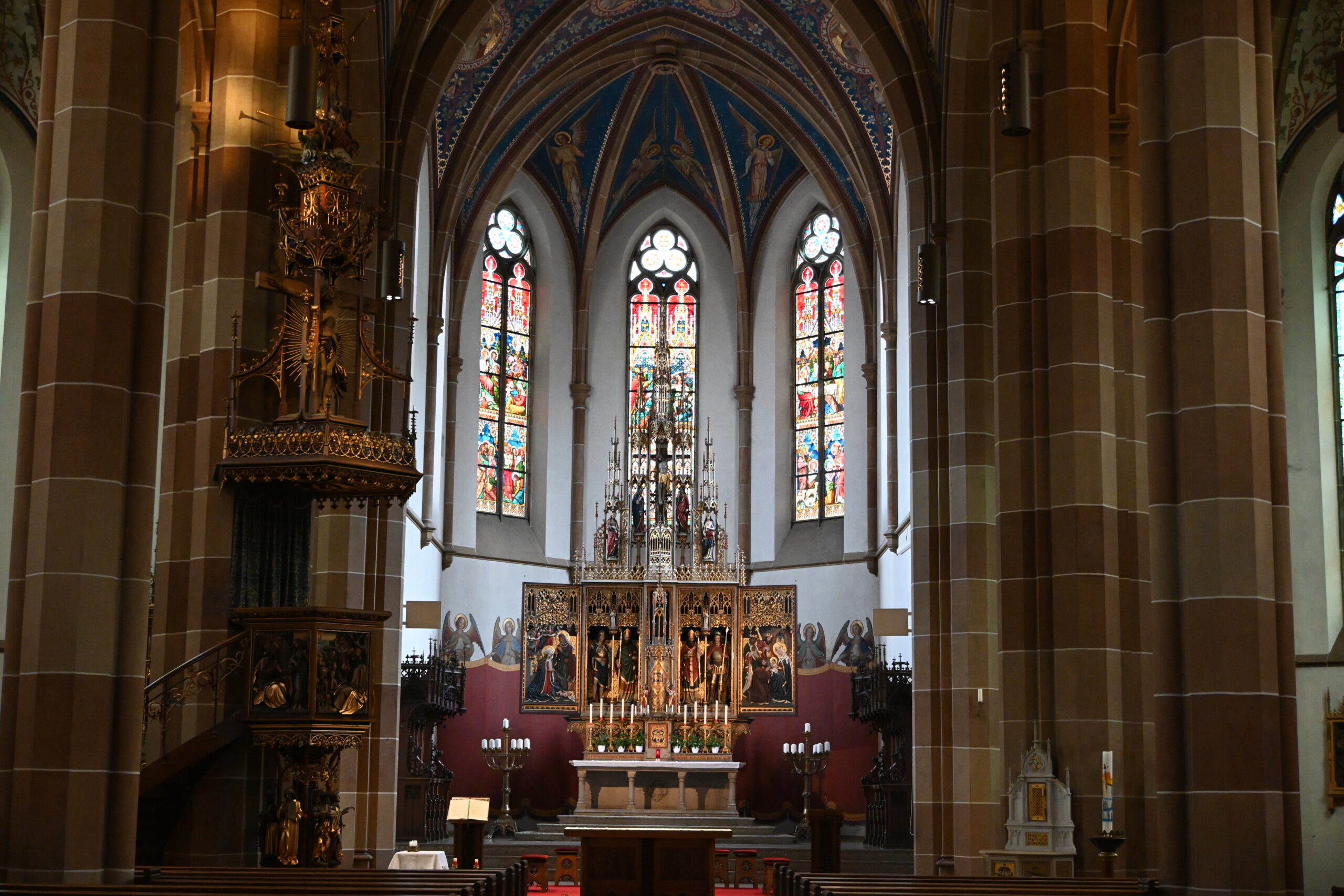Tyrolean Glass Painting and Mosaic Institute
Glasmalereistraße / Müllerstraße
Worth knowing
The Tiroler Glasmalerei- und Mosaikanstalt was perhaps Innsbruck's most internationally successful industrial enterprise in the late 19th and early 20th centuries. The influence that the company had on Innsbruck can hardly be overestimated. The architecture of the factory building in Wilten reflects the exceptional skills of the artists and craftsmen. Unlike many other entrepreneurs, the art-loving company founders attached great importance to the aesthetics of their plant. The co-founder of the company and master builder Josef von Stadl created a factory building, the core of which still exists today. The facility had to manage the balancing act between art workshop, exhibition space, offices and industrial production for large orders with more than a hundred windows.
If you enter the complex, which opened in 1870, from Müllerstraße, you will notice the marble plaque framed by mosaics, which commemorates the visits of Emperor Franz Josef. I. The statue of St Barbara above the entrance, like the rest of the core of the three-storey main building, has been preserved to this day despite many renovations. The neo-Romanesque main building, decorated with gold lettering, is reminiscent of a church in its formal language. A medieval-looking lamp with an Austrian emblem hangs in front of the entrance. In the inner courtyard, several preserved works in different styles bear witness to the craftsmanship of different eras. Opposite the entrance portal, a Habsburg coat of arms with a double-headed eagle and an Orthodox-style depiction of the Mother of God with Christ the King on her lap in gold adorn the façade. In the rear courtyard of the main building, you can see the production halls and workshops that were added in 1884. A mosaic of the Mother of God in Art Nouveau style hangs somewhat apart in the corridor between the wings of the building. The gable of the western façade in Glasmalereistraße is crowned by a Madonna and Christ Child in gold.
The history of the Tyrolean stained glass and mosaic centre is at least as interesting as the building itself. After centuries in which glass painting had sunk into insignificance, this craft made a comeback in the slipstream of the new architectural styles of historicism and under the patronage of King Ludwig in the form of Germany's first industrial glass painting studio. In Tyrol, it took many coincidences and three remarkable men to launch this important craft for sacred buildings.
Josef von Stadl and Georg Mader from Steinach and Albert Neuhauser from Innsbruck founded the Tyrolean stained glass workshop in 1861. Four years later, over 450 windows had already been produced. The workshop grew, which necessitated a move to the Baur's house of the textile manufacturer Franz Baur. These premises soon became too small for the company and its future plans. Construction of the new factory premises in Wilten began in 1869. In the same year, production of the company's own raw material, glass, began in the workshop under the technical direction of the inventor Neuhauser. When the space inside the factory became too small for glass production, a factory-owned cathedral glassworks was built in 1872 on the Wilten fields at the site of today's Schöpfstraße 19, where the precious raw material was produced on a large scale until 1899.
After the economic crisis of 1873, the construction industry flourished under the masses of orders from the public sector and with it Tyrolean glass painting. From the very beginning, the stained glass factory was characterised by its good connections and its large network, not only within the Danube Monarchy. The first overseas commission left the factory for the USA as early as 1871. After 1873, the company was a regular guest at the then popular world exhibitions. The best-known works in Innsbruck are probably the windows of the municipal baths in Salurnerstraße, St Nicholas Church and the Evangelical Church of Christ.
In 1874, Neuhauser had to leave the company for health reasons. He was succeeded by Albert Jele as the new director of the stained glass workshop and partner. Under his aegis, the company expanded significantly. Jele was an art historian, widely travelled and spoke several languages. With its international branches, Tiroler Glasmalerei became a global player in its sector. In 1880, the company expanded to Vienna. Art Nouveau artists, expressionists and modern architects discovered the colourful windows from Wilten for projects outside of church construction. The works of art were supplied as far afield as India and Australia. In 1891, the new management opened a branch in New York to avoid the import duties of 45% in the USA.
Meanwhile, Neuhauser founded the Tyrolean Mosaic Institute. In 1900, his solo project merged with the parent company to form the Tyrolean Glass Painting and Mosaic Institute. In Innsbruck, the parish churches of St Nicholas, Dreiheiligen and Hötting, Wilten Basilica, the Monastery of Perpetual Adoration, the Collegium Canisianum, the Chamber of Commerce, TIWAG on Landhausplatz and the Wilten Art Clinic all have mosaics made by the Wilten art company. The two cemeteries in Pradl and Wilten also display the skills of the mosaic workshop in various places. On the low buildings in Müllerstraße, a mosaic above the entrance is a reminder of the former purpose of the otherwise inconspicuous building. The adjoining building at Glasmalereistraße 8 was built the following year by the Innsbruck master builder Anton Fritz as a residence for Jele on Glasmalereistraße, which had been built shortly before. The architect did not break with the neo-Romanesque style of the factory building opposite and used the church-like round arches and Art Nouveau elements. Above the entrance door, a window in the style of the turn of the century shows a boat. In 1929, the Mader family bought the house and had it remodelled by Franz Baumann in the style of the Neuen Sachlichkeit The building will be extended by a third floor while retaining the original building core.
Even though the golden age of stained glass was over with the end of the monarchy, the business was able to survive. Fresh input from changing artists and artistic directors, including big names such as Hans Andre, Max Weiler, Ernst Nepo and Max Spielmann, kept the business going. In 1929, the Mader building in Glasmalereistraße was remodelled according to Franz Baumann's plans together with the addition of a new storey. In 1944, the stained glass and mosaic workshop was badly damaged in an air raid. Reconstruction began immediately after the war. Since 2000, the western part of the listed building has been home to an inn. The company continues to produce high-quality stained glass to this day, now in its fifth generation. From the historicism of the Belle Epoque to the expressionism of the interwar period and abstract art after 1945, stained glass has accompanied the Tyrolean architecture and art scene for over 150 years.
The success story of the Innsbruck glass painters
In the pre-war period, the United States of America was regarded as the Land of unlimited possibilitieswhere dishwashers became millionaires. However, these success stories are not an exclusive phenomenon of the New World. Even in the society of the Danube Monarchy, which was not yet regulated down to the last detail, hard-working and capable people from the farming classes, the working classes or craftsmen were able to achieve astonishing success without formal training, qualification examinations or state authorisation. The three founders of the Tyrolean Glass Painting and Mosaic InstituteJosef von Stadl, Georg Mader and Albert Neuhauser, are examples of such a success story from Innsbruck's city history.
Josef von Stadl (1828 - 1893) grew up on his parents' farm and inn in Steinach am Brenner. Even as a child, he had to help out on the farm. The hard labour gave him periostitis in his arm at the age of nine. This made heavy physical labour impossible for him. Instead, the boy with a talent for drawing attended the model secondary school in Innsbruck, now the BORG. In 1848, he joined the Tyrolean snipers in his home town, but was not called up to fight on the country's borders. He then gained experience as a locksmith and turner. The talented young man worked on the reconstruction of the church in Steinach in 1853 after a village band. His skills were soon recognised and he gradually rose from labourer to master builder.
Georg Mader (1824 - 1881) also came from Steinach. He too had to work as a farm labourer at a young age. On the patronage of his brother, a clergyman, the pious youth was able to complete an apprenticeship with a painter, but had to give up his passion to work in the local mill. After his journeyman's journey, he decided to concentrate on painting. In Munich, he deepened his knowledge under Kaulbach and Schraudolph. After working on the cathedral in Speyer, he returned to Tyrol. As a history painter, he kept his head above water with commissions from the church.
Albert Neuhauser (1832 - 1901) learnt his trade in his father's glazier's and tinsmith's shop. He also had to give up his intended career path at an early age. He developed lung problems at the age of ten. Instead of working in his father's successful business, he travelled to Venice. For centuries, Murano had been home to the best glassworks for artistic glass production. Fascinated by this trade, he attended the stained glass school in Munich against his father's wishes. The products of the recently founded Bavarian factory did not meet his quality expectations. In his father's flat in Herzog-Friedrich-Straße, he undertook his first experiments with glass, similar to the nerds who would lay the foundations for the personal computer in their own garage a hundred years later.
Neuhauser's tinkering and experiments aroused the curiosity of his friend von Stadl. He made contact with the art-loving Mader. In 1861, the three decided to pool their expertise in an official company. Today, the founding of the company would probably be referred to as a start-up. Neuhauser took on the technical and commercial side as well as product development, Von Stadl took care of the decorative aspects and liaised with master builders and Mader took on the figurative design of the works, most of which were created for churches. The first branch, consisting of two painters and a burner, was set up on the third floor of the Gasthof zur Rose in the historic city centre. The raw material came from England, as the local glass did not meet Neuhauser's high quality standards. However, 25% duty was added to the import. Together with a chemistry teacher, Neuhauser managed to achieve the desired requirements himself after a trip to Birmingham and a lot of tinkering.
Josef von Stadl married the painter and doctor's daughter Maria Pfefferer in 1867. The farmer's boy from the Wipptal valley with the broken arm had not only become a member of the upper middle class, his wife's dowry also allowed him to live independently financially. In 1869, the three partners decided to expand the successful glass painting business with the financial support of Neuhauser's father. How dynamic and unregulated it was as a Wilhelminian style The example of the glassworks on the Wiltener Felder, which was opened in 1872 as an additional part of the Tyrolean Stained glass went into operation. Only 110 days after the start of construction, which was never officially authorised by the Wilten municipal administration, production began.
Starting with Neuhauser, who had to leave the company in 1874 due to health problems, the three company founders soon left their start-up to others, but remained partners in the Tyrolean stained glass company. In addition to their activities for the joint company, each of the three partners worked successfully on their own projects in their respective fields of activity.
Von Stadl had a lasting impact on Innsbruck. In its heyday, the number of employees at the stained glass factory had risen to over 70. In 1878, residential buildings for the company's employees, workers, artists and craftsmen were built according to von Stadl's plans. The Stained glass settlement comprised the houses at Müllerstrasse 39 - 57, Schöpfstrasse 18 - 24 and Speckbacherstrasse 14 - 16, which still exist today and differ markedly in their architecture from the neighbouring houses of the late Gründerzeit. Von Stadl was more sparing with the decoration of the houses, but was careful to include a small front garden. It was not unusual for large companies of the time to plan their own housing estates - think of Siemensstadt in Berlin - but it speaks to a certain self-confidence and a vision for the future when a company like the stained glass factory sees itself not only as a provider of labour and wages, but also as a provider of accommodation for its employees. The state maternity hospital in Wilten was another major project in Innsbruck that was realised under von Stadl's pen. After the construction of the Vinzentinum in 1878, he was made an honorary citizen and diocesan architect of Brixen. Pope Leo XIII awarded him the Order of St Gregory for his services. St Nicholas' Church, for which the Tyrolean stained glass company had produced the windows, became his final resting place.
Georg Mader continued to work as a painter on sacred buildings. He became a member of the Vienna Academy of Art as early as 1868. When he suffered a stroke in 1881, he was taken to Badgastein for rehabilitation. The spa town in Salzburg was a meeting place for the European aristocracy and upper middle classes at the time. In the midst of high society, the former journeyman miller died a wealthy man.
The restless and creative Neuhauser travelled to Venice again after resigning from his post as director of the Tyrolean stained glass workshop in order to found Austria's first mosaic studio with new inspiration. The merger of the two companies in 1900 opened up a wider range of opportunities. He was awarded the Order of Franz Joseph for his artistic merits. Neuhauserstraße in Wilten was named after him.
Innsbruck's industrial revolutions
In the 15th century, the first early form of industrialisation began to develop in Innsbruck. Bell and weapon founders such as the Löfflers built factories in Hötting, Mühlau and Dreiheiligen, which were among the leading factories of their time. Between the Sill gorge and Dreiheiligen, a number of mills and businesses utilised the energy provided by the Sill Canal. There was a munitions factory in what is now Adamgasse, which exploded in 1636, and a hammer mill was located in Jahnstraße. Work and money attracted a new class of people. Industry not only changed the rules of the social game with the influx of new workers and their families, it also had an impact on the appearance of Innsbruck. Unlike the farmers, the labourers were not the subjects of any master. Although entrepreneurs were not of noble blood, they often had more capital at their disposal than the aristocracy. The old hierarchies still existed, but were beginning to become at least somewhat fragile. The new citizens brought with them new fashions and dressed differently. Capital from outside came into the city. Houses and churches were built for the newly arrived subjects. The large workshops changed the smell and sound of the city. The smelting works were loud, the smoke from the furnaces polluted the air.
The second wave of industrialisation came late in Innsbruck compared to other European regions. The Small craftThe town's former craft businesses, which were organised in guilds, came under pressure from the achievements of modern goods production. In St. Nikolaus, Wilten, Mühlau and Pradl, modern factories were built along the Mühlbach stream and the Sill Canal. Many innovative company founders came from outside Innsbruck. Peter Walde, who moved to Innsbruck from Lusatia, founded his company in 1777 in what is now Innstrasse 23, producing products made from fat, such as tallow candles and soaps. Eight generations later, Walde is still one of the oldest family businesses in Austria. Today you can buy the result of centuries of tradition in soap and candle form in the listed main building with its Gothic vaults. Franz Josef Adam came from the Vinschgau Valley to found the city's largest brewery to date in a former aristocratic residence. In 1838, the spinning machine arrived via the Dornbirn company Herrburger & Rhomberg over the Arlberg to Pradl. H&R had acquired a plot of land on the Sillgründe. Thanks to the river's water power, the site was ideal for the heavy machinery used in the textile industry. In addition to the traditional sheep's wool, cotton was now also processed.
Just like 400 years earlier, the Second Industrial Revolution changed the city and the everyday lives of its inhabitants forever. Neighbourhoods such as Mühlau, Pradl and Wilten grew rapidly. The factories were often located in the centre of residential areas. Over 20 businesses were still using the Sill Canal around 1900. The Haidmühle The power plant in Salurnerstraße existed from 1315 to 1907 and supplied a textile factory in Dreiheiligenstraße with energy from the Sill Canal. The noise and exhaust fumes from the engines were hell for the neighbours, as a newspaper article from 1912 shows:
„Entrüstung ruft bei den Bewohnern des nächst dem Hauptbahnhofe gelegenen Stadtteiles der seit einiger Zeit in der hibler´schen Feigenkaffeefabrik aufgestellte Explosionsmotor hervor. Der Lärm, welchen diese Maschine fast den ganzen Tag ununterbrochen verbreitet, stört die ganz Umgebung in der empfindlichsten Weise und muß die umliegenden Wohnungen entwerten. In den am Bahnhofplatze liegenden Hotels sind die früher so gesuchten und beliebten Gartenzimmer kaum mehr zu vermieten. Noch schlimmer als der ruhestörende Lärm aber ist der Qualm und Gestank der neuen Maschine…“
Aristocrats who rested too long on their birth earnings while the economic and social rules of the game changed had to sell their estates to the new moneyed aristocracy. Skilful individuals took advantage of their opportunities and invested family property and income from the 1848 land relief in industry and business. The growing demand for labour was met by former farmhands and farmers without land. While the new wealthy entrepreneurial class had villas built in Wilten, Pradl and Saggen and middle-class employees lived in apartment buildings in the same neighbourhoods, the workers were housed in workers' hostels and mass accommodation. Some worked in businesses such as the gas works, the quarry or in one of the factories, while others consumed the wealth. Shifts of 12 hours in cramped, noisy and sooty conditions demanded everything from the workers. Child labour was not banned until the 1840s. Women earned only a fraction of what men were paid. Workers often lived in tenements built by their employers and were at their mercy due to the lack of labour laws. There was no social security or unemployment insurance. Those who were unable to work had to rely on the welfare organisations of their home town. It should be noted that this everyday life of labourers, which we find terrifying, was no different from the working conditions in the villages, but developed from them. Child labour, inequality and precarious working conditions were also the norm in agriculture.
However, industrialisation did not only affect everyday material life. Innsbruck experienced the kind of gentrification that can be observed today in trendy urban neighbourhoods such as Prenzlauer Berg in Berlin. The change from the rural life of the village to the city involved more than just a change of location. In one of his texts, the Innsbruck writer Josef Leitgeb tells us how people experienced the urbanisation of what was once a rural area:
„…viel fremdes, billig gekleidetes Volk, in wachsenden Wohnblocks zusammengedrängt, morgens, mittags und abends die Straßen füllend, wenn es zur Arbeit ging oder von ihr kam, aus Werkstätten, Läden, Fabriken, vom Bahndienst, die Gesichter oft blaß und vorzeitig alternd, in Haltung, Sprache und Kleidung nichts Persönliches mehr, sondern ein Allgemeines, massenhaft Wiederholtes und Wiederholbares: städtischer Arbeitsmensch. Bahnhof und Gaswerk erschienen als Kern dieser neuen, unsäglich fremden Landschaft.“
For many Innsbruck residents, the revolutionary year of 1848 and the new economic circumstances led to bourgeoisie. There were always stories of people who rose through the ranks with hard work, luck, talent and a little financial start-up aid. Well-known Innsbruck examples outside the hotel and catering industry that still exist today are the Tyrolean stained glass business, the Hörtnagl grocery store and the Walde soap factory. Successful entrepreneurs took over the former role of the aristocratic landlords. Together with the numerous academics, they formed a new class that also gained more and more political influence. Beda Weber wrote about this in 1851:
„Their social circles are without constraint, and there is a distinctly metropolitan flavour that is not so easy to find elsewhere in Tyrol."
The workers also became bourgeois. While the landlord in the countryside was still master of the private lives of his farmhands and maidservants and was able to determine their lifestyle up to and including sexuality via the release for marriage, the labourers were now at least somewhat freer individually. They were poorly paid, but at least they now received their own wages instead of board and lodging and were able to organise their private affairs for themselves without the landlord's guardianship.
The downside of this newfound self-determination was particularly evident in the first decades of industrialisation. There was hardly any state infrastructure for health and family care. Health care, pensions, old people's homes and kindergartens had not yet been invented, and in many cases the extended farming family had taken over these tasks until then. In the working-class neighbourhoods, unsupervised children romped around during the day: the youngest children, who were not yet subject to compulsory schooling, were particularly affected. In 1834, following an appeal by the Tyrolean provincial governor, a women's association was founded, which Child detention centres in the working-class neighbourhoods of St. Nikolaus, Dreiheiligen and Angerzell, now Museumstraße. The aim was not only to keep the children off the streets and provide them with clothing and food, but also to teach them manners, proper expression and virtuous behaviour. With a strict hand for "cleanliness, order and obedience", the wardens ensured that the children received at least a minimum level of care. The former Preservation centre in Paul-Hofhaimer-Gasse behind the Ferdinandeum still exists today. The classicist building now houses the Caritas integration kindergarten and a company kindergarten run by the state of Tyrol.
Innsbruck is not a traditional working-class city. Nevertheless, Tyrol never saw the formation of a significant labour movement as in Vienna. Innsbruck has always been predominantly a commercial and university city. Although there were social democrats and a handful of communists, the number of workers was always too small to really make a difference. May Day marches are only attended by the majority of people for cheap schnitzel and free beer. There are hardly any other memorials to industrialisation and the achievements of the working class. In St.-Nikolaus-Gasse and in many tenement houses in Wilten and Pradl, a few houses have been preserved that give an impression of the everyday life of Innsbruck's working class.
March 1848... and what it brought
The year 1848 occupies a mythical place in European history. Although the hotspots were not to be found in secluded Tyrol, but in the major metropolises such as Paris, Vienna, Budapest, Milan and Berlin, even in the Holy Land however, the revolutionary year left its mark. In contrast to the rural surroundings, an enlightened educated middle class had developed in Innsbruck. Enlightened people no longer wanted to be subjects of a monarch or sovereign, but citizens with rights and duties towards the state. Students and freelancers demanded political participation, freedom of the press and civil rights. Workers demanded better wages and working conditions. Radical liberals and nationalists in particular even questioned the omnipotence of the church.
In March 1848, this socially and politically highly explosive mixture erupted in riots in many European cities. In Innsbruck, students and professors celebrated the newly enacted freedom of the press with a torchlight procession. On the whole, however, the revolution proceeded calmly in the leisurely Tyrol. It would be foolhardy to speak of a spontaneous outburst of emotion; the date of the procession was postponed from 20 to 21 March due to bad weather. There were hardly any anti-Habsburg riots or attacks; a stray stone thrown into a Jesuit window was one of the highlights of the Alpine version of the 1848 revolution. The students even helped the city magistrate to monitor public order in order to show their gratitude to the monarch for the newly granted freedoms and their loyalty.
The initial enthusiasm for bourgeois revolution was quickly replaced by German nationalist, patriotic fervour in Innsbruck. On 6 April 1848, the German flag was waved by the governor of Tyrol during a ceremonial procession. A German flag was also raised on the city tower. Tricolour was hoisted. While students, workers, liberal-nationalist-minded citizens, republicans, supporters of a constitutional monarchy and Catholic conservatives disagreed on social issues such as freedom of the press, they shared a dislike of the Italian independence movement that had spread from Piedmont and Milan to northern Italy. Innsbruck students and marksmen marched to Trentino with the support of the k.k. The Innsbruck students and riflemen moved into Trentino to nip the unrest and uprisings in the bud. Well-known members of this corps were Father Haspinger, who had already fought with Andreas Hofer in 1809, and Adolf Pichler. Johann Nepomuk Mahl-Schedl, wealthy owner of Büchsenhausen Castle, even equipped his own company with which he marched across the Brenner Pass to secure the border.
The city of Innsbruck, as the political and economic centre of the multinational crown land of Tyrol and home to many Italian speakers, also became the arena of this nationality conflict. Combined with copious amounts of alcohol, anti-Italian sentiment in Innsbruck posed more of a threat to public order than civil liberties. A quarrel between a German-speaking craftsman and an Italian-speaking Ladin got so heated that it almost led to a pogrom against the numerous businesses and restaurants owned by Italian-speaking Tyroleans.
The relative tranquillity of Innsbruck suited the imperial house, which was under pressure. When things did not stop boiling in Vienna even after March, Emperor Ferdinand fled to Tyrol in May. According to press reports from this time, he was received enthusiastically by the population.
"Wie heißt das Land, dem solche Ehre zu Theil wird, wer ist das Volk, das ein solches Vertrauen genießt in dieser verhängnißvollen Zeit? Stützt sich die Ruhe und Sicherheit hier bloß auf die Sage aus alter Zeit, oder liegt auch in der Gegenwart ein Grund, auf dem man bauen kann, den der Wind nicht weg bläst, und der Sturm nicht erschüttert? Dieses Alipenland heißt Tirol, gefällts dir wohl? Ja, das tirolische Volk allein bewährt in der Mitte des aufgewühlten Europa die Ehrfurcht und Treue, den Muth und die Kraft für sein angestammtes Regentenhaus, während ringsum Auflehnung, Widerspruch. Trotz und Forderung, häufig sogar Aufruhr und Umsturz toben; Tirol allein hält fest ohne Wanken an Sitte und Gehorsam, auf Religion, Wahrheit und Recht, während anderwärts die Frechheit und Lüge, der Wahnsinn und die Leidenschaften herrschen anstatt folgen wollen. Und während im großen Kaiserreiche sich die Bande überall lockern, oder gar zu lösen drohen; wo die Willkühr, von den Begierden getrieben, Gesetze umstürzt, offenen Aufruhr predigt, täglich mit neuen Forderungen losgeht; eigenmächtig ephemere- wie das Wetter wechselnde Einrichtungen schafft; während Wien, die alte sonst so friedliche Kaiserstadt, sich von der erhitzten Phantasie der Jugend lenken und gängeln läßt, und die Räthe des Reichs auf eine schmähliche Weise behandelt, nach Laune beliebig, und mit jakobinischer Anmaßung, über alle Provinzen verfügend, absetzt und anstellt, ja sogar ohne Ehrfurcht, den Kaiaer mit Sturm-Petitionen verfolgt; während jetzt von allen Seiten her Deputationen mit Ergebenheits-Addressen mit Bittgesuchen und Loyalitätsversicherungen dem Kaiser nach Innsbruck folgen, steht Tirol ganz ruhig, gleich einer stillen Insel, mitten im brausenden Meeressturme, und des kleinen Völkchens treue Brust bildet, wie seine Berge und Felsen, eine feste Mauer in Gesetz und Ordnung, für den Kaiser und das Vaterland."
In June, a young Franz Josef, not yet emperor at the time, also stayed at the Hofburg on his way back from the battlefields of northern Italy instead of travelling directly to Vienna. Innsbruck was once again the royal seat, if only for one summer. While blood was flowing in Vienna, Milan and Budapest, the imperial family enjoyed life in the Tyrolean countryside. Ferdinand, Franz Karl, his wife Sophie and Franz Josef received guests from foreign royal courts and were chauffeured in four-in-hand carriages to the region's excursion destinations such as Weiherburg Castle, Stefansbrücke Bridge, Kranebitten and high up to Heiligwasser. A little later, however, the cosy atmosphere came to an end. Under gentle pressure, Ferdinand, who was no longer considered fit for office, passed the torch of regency to Franz Josef I. In July 1848, the first parliamentary session was held in the Court Riding School in Vienna. The first constitution was enacted. However, the monarchy's desire for reform quickly waned. The new parliament was an imperial council, it could not pass any binding laws, the emperor never attended it during his lifetime and did not understand why the Danube Monarchy, as a divinely appointed monarchy, needed this council.
Nevertheless, the liberalisation that had been gently set in motion took its course in the cities. Innsbruck was given the status of a town with its own statute. Innsbruck's municipal law provided for a right of citizenship that was linked to ownership or the payment of taxes, but legally guaranteed certain rights to members of the community. Birthright citizenship could be acquired by birth, marriage or extraordinary conferment and at least gave male adults the right to vote at municipal level. If you got into financial difficulties, you had the right to basic support from the town.
Thanks to the census-based majority voting system, the Greater German liberal faction prevailed within the city government, in which merchants, tradesmen, industrialists and innkeepers set the tone. On 2 June 1848, the first edition of the liberal and Greater German-minded Innsbrucker Zeitungfrom which the above article on the emperor's arrival in Innsbruck is taken. Conservatives, on the other hand, read the Volksblatt for Tyrol and Vorarlberg. Moderate readers who favoured a constitutional monarchy preferred to consume the Bothen for Tyrol and Vorarlberg. However, the freedom of the press soon came to an end. The previously abolished censorship was reintroduced in parts. Newspaper publishers had to undergo some harassment by the authorities. Newspapers were not allowed to write against the state government, monarchy or church.
"Anyone who, by means of printed matter, incites, instigates or attempts to incite others to take action which would bring about the violent separation of a part from the unified state... of the Austrian Empire... or the general Austrian Imperial Diet or the provincial assemblies of the individual crown lands.... Imperial Diet or the Diet of the individual Crown Lands... violently disrupts... shall be punished with severe imprisonment of two to ten years."
After Innsbruck officially replaced Meran as the provincial capital in 1849 and thus finally became the political centre of Tyrol, political parties were formed. From 1868, the liberal and Greater German orientated party provided the mayor of the city of Innsbruck. The influence of the church declined in Innsbruck in contrast to the surrounding communities. Individualism, capitalism, nationalism and consumerism stepped into the breach. New worlds of work, department stores, theatres, cafés and dance halls did not supplant religion in the city either, but the emphasis changed as a result of the civil liberties won in 1848.
Perhaps the most important change to the law was the Basic relief patent. In Innsbruck, the clergy, above all Wilten Abbey, held a large proportion of the peasant land. The church and nobility were not subject to taxation. In 1848/49, manorial rule and servitude were abolished in Austria. Land rents, tithes and roboters were thus abolished. The landlords received one third of the value of their land from the state as part of the land relief, one third was regarded as tax relief and the farmers had to pay one third of the relief themselves. They could pay off this amount in instalments over a period of twenty years.
The after-effects can still be felt today. The descendants of the then successful farmers enjoy the fruits of prosperity through inherited land ownership, which can be traced back to the land relief of 1848, as well as political influence through land sales for housing construction, leases and public sector redemptions for infrastructure projects. The land-owning nobles of the past had to resign themselves to the ignominy of pursuing middle-class labour. The transition from birthright to privileged status within society was often successful thanks to financial means, networks and education. Many of Innsbruck's academic dynasties began in the decades after 1848.
The hitherto unknown phenomenon of leisure time emerged, albeit sparsely for the most part, and, together with disposable income, favoured hobbies for a larger number of people. Civil organisations and clubs, from reading circles to singing societies, fire brigades and sports clubs, were founded. The revolutionary year also manifested itself in the cityscape. Parks such as the English Garden at Ambras Castle or the Hofgarten were no longer the exclusive preserve of the aristocracy, but served as recreational areas for the citizens to escape their cramped existence. In St. Nikolaus, on the site of the raft landing stage on the Inn, the Waltherpark. Tyrol's first swimming and bathing centre opened one floor higher in Büchsenhausen Castle, followed shortly afterwards by another bath in Dreiheiligen. Excursion inns flourished around Innsbruck. In addition to the upscale restaurants and hotels, a scene of inns emerged in which workers and employees could also enjoy cosy evenings with theatre, music and dancing.
Klingler, Huter, Retter & Co: master builders of expansion
The last decades of the 19th century were characterised Wilhelminian style in the history of Austria. After an economic crisis in 1873, the city began to expand in a period of recovery. From 1880 to 1900, Innsbruck's population grew from 20,000 to 26,000. Wilten, which was incorporated in 1904, tripled from 4,000 to 12,000. The infrastructure also changed in the wake of technical innovations. Gas, water and electricity became part of everyday life for more and more people. The old town hospital gave way to the new hospital. The orphanage and Sieberer's old people's asylum were built in Saggen. Innsbruck's first telephone went into service in 1893. By the turn of the century, there were already over 300 lines in the city.
The buildings constructed in the new neighbourhoods were a reflection of this new society. Entrepreneurs, freelancers, employees and workers with political voting rights developed different needs than subjects without this right. Unlike in rural Tyrol, where farming families lived in farmhouses together with farmhands and maidservants as a clan, life in the city came close to the family life we know today. The living space had to correspond to this. The lifestyle of city dwellers demanded multi-room flats and open spaces for relaxation after work. The wealthy middle classes, consisting of entrepreneurs and freelancers, had not yet overtaken the aristocracy, but they had narrowed the gap. They were the ones who not only commissioned private building projects, but also decided on public buildings through their position on the local council.
The 40 years before the First World War were a kind of gold-rush period for construction companies, craftsmen, master builders and architects. The buildings reflected the world view of their clients. Master builders combined several roles and often replaced the architect. Most clients had very clear ideas about what they wanted. They were not to be breathtaking new creations, but copies and references to existing buildings. In keeping with the spirit of the times, the Innsbruck master builders designed the buildings in the styles of historicism and classicism as well as the Tyrolean Heimatstil in accordance with the wishes of the financially strong clients. The choice of style used to build a home was often not only a visual but also an ideological statement by the client. Liberals usually favoured classicism, while conservatives were in favour of the Tyrolean Heimatstil. While the Heimatstil was neo-baroque and featured many paintings, clear forms, statues and columns were style-defining elements in the construction of new classicist buildings. The ideas that people had of classical Greece and ancient Rome were realised in a sometimes wild mix of styles. Not only railway stations and public buildings, but also large apartment blocks and entire streets, even churches and cemeteries were built in this design along the old corridors. The upper middle classes showed their penchant for antiquity with neoclassical façades. Catholic traditionalists had images of saints and depictions of Tyrol's regional history painted on the walls of their Heimatstil houses. While neoclassicism dominates in Saggen and Wilten, most of the buildings in Pradl are in the conservative Heimatstil style.
For a long time, many building experts turned up their noses at the buildings of the upstarts and nouveau riche. Heinrich Hammer wrote in his standard work "Art history of the city of Innsbruck":
"Of course, this first rapid expansion of the city took place in an era that was unfruitful in terms of architectural art, in which architecture, instead of developing an independent, contemporary style, repeated the architectural styles of the past one after the other."
The era of large villas, which imitated the aristocratic residences of days gone by with a bourgeois touch, came to an end after a few wild decades due to a lack of space. Further development of the urban area with individual houses was no longer possible, the space had become too narrow. In 1898, the municipal council decided to authorise only blocks of flats east of Claudiastrasse instead of the villas in the spacious cottage style. The Falkstrasse / Gänsbachstrasse / Bienerstrasse area is still regarded as the Villensaggenthe areas to the east as Blocksaggen. In Wilten and Pradl, this type of development did not even occur. Nevertheless, master builders sealed more and more ground in the gold rush. Albert Gruber gave a cautionary speech on this growth in 1907, in which he warned against uncontrolled growth in urban planning and land speculation.
"It is the most difficult and responsible task facing our city fathers. Up until the 1980s (note: 1880), let's say in view of our circumstances, a certain slow pace was maintained in urban expansion. Since the last 10 years, however, it can be said that cityscapes have been expanding at a tremendous pace. Old houses are being torn down and new ones erected in their place. Of course, if this demolition and construction is carried out haphazardly, without any thought, only for the benefit of the individual, then disasters, so-called architectural crimes, usually occur. In order to prevent such haphazard building, which does not benefit the general public, every city must ensure that individuals cannot do as they please: the city must set a limit to unrestricted speculation in the area of urban expansion. This includes above all land speculation."
A handful of master builders and the Innsbruck building authority accompanied this development in Innsbruck. If Wilhelm Greil is described as the mayor of the expansion, the Viennese-born Eduard Klingler (1861 - 1916) probably deserves the title of its architect. Klingler played a key role in shaping Innsbruck's cityscape in his role as a civil servant and master builder. He began working for the state of Tyrol in 1883. In 1889, he joined the municipal building department, which he headed from 1902. In Innsbruck, the commercial academy, the Leitgebule school, the Pradl cemetery, the dermatological clinic in the hospital area, the municipal kindergarten in Michael-Gaismair-Straße, the Trainkaserne (note: today a residential building), the market hall and the Tyrolean State Conservatory are all attributable to Klingler as head of the building department. The Ulrichhaus on Mount Isel, which is now home to the Alt-Kaiserjäger-Club, is a building worth seeing in the Heimatstil style based on his design.
Perhaps the most important construction office in Innsbruck was Johann Huter & Sons. Johann Huter took over his father's small construction business. In 1856, he acquired the first company premises, the Hutergründeon the Innrain. Three years later, the first prestigious headquarters were built in Meranerstraße. The company registration together with his sons Josef and Peter in 1860 marked the official start of the company that still exists today. Huter & Söhne like many of its competitors, saw itself as a complete service provider. The company had its own brickworks, a cement factory, a joinery and a locksmith's shop as well as a planning office and the actual construction company. In 1906/07, the Huters built their own company headquarters at Kaiser-Josef-Straße 15 in the typical style of the last pre-war years. The stately house combines the Tyrolean Heimatstil surrounded by gardens and nature with neo-Gothic and neo-Romanesque elements. Famous from Huter & Söhne buildings in Innsbruck include the Monastery of Perpetual Adoration, the parish church of St Nicholas and several buildings on Claudiaplatz.
The second big player was Josef Retter. Born in Tyrol, he grew up in the Wachau region. In his early youth, he completed an apprenticeship as a bricklayer before he left the k.k. State Trade School in Vienna and attended the foreman's school in the building trade department. After gaining professional experience in Vienna, Croatia and Bolzano throughout the Danube Monarchy, he was able to open his own construction company in Innsbruck at the age of 29 thanks to his wife's dowry. Like Huter, his company also included a sawmill, a sand and gravel works and a workshop for stonemasonry work. In 1904, he opened his residential and office building at Schöpfstraße 23a, which is still used today as a Rescuer's house is well known. With a new building for the Academic Grammar School and the castle-like school building for the Commercial Academy and the Evangelical Church of Christ in Saggen, the stately Sonnenburg in Wilten and the neo-Gothic Mentlberg Castle on Sieglanger, he realised some of Innsbruck's most outstanding buildings of the period to this day.
Late in life but with a similarly practice-orientated background that was typical of 19th century master builders, Anton Fritz started his construction company in 1888. He grew up remotely in Graun in the Vinschgau Valley. After working as a foreman, plasterer and bricklayer, he decided to attend the trade school in Innsbruck at the age of 36. Talent and luck brought him his breakthrough as a planner with the country-style villa at Karmelitergasse 12. In its heyday, his construction company employed 150 people. In 1912, shortly before the outbreak of the First World War and the resulting slump in the construction industry, he handed over his company to his son Adalbert. Anton Fritz's legacy includes his own home at Müllerstraße 4, the Mader house in Glasmalereistraße and houses on Claudiaplatz and Sonnenburgplatz.
With Carl Kohnle, Carl Albert, Karl Lubomirski and Simon Tommasi, Innsbruck had other master builders who immortalised themselves in the cityscape with buildings typical of the late 19th century. They all made Innsbruck's new streets shine in the prevailing architectural zeitgeist of the last 30 years of the Danube Monarchy. Residential buildings, railway stations, official buildings and churches in the vast empire between the Ukraine and Tyrol looked similar across the board. New trends such as Art Nouveau emerged only hesitantly. In Innsbruck, it was the Munich architect Josef Bachmann who set a new accent in civic design with the redesign of the façade of the Winklerhaus. Building activity came to a halt at the beginning of the First World War. After the war, the era of neoclassical historicism and Heimatstil was finally history. Walks in Saggen and parts of Wilten and Pradl take you back to the Wilhelminian era. Claudiaplatz and Sonnenburgplatz are among the most impressive examples. The building company Huter and Sons still exists today. The company is now located in Sieglanger in Josef-Franz-Huter-Straße, named after the company founder.
